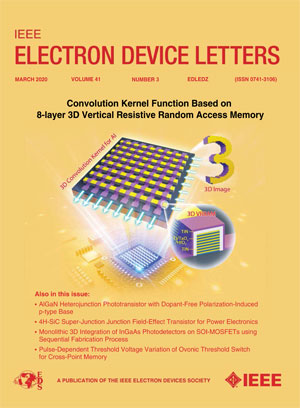通过金属添加层优化铯硼铍微阵列的场发射特性
IF 4.1
2区 工程技术
Q2 ENGINEERING, ELECTRICAL & ELECTRONIC
引用次数: 0
摘要
在过去十年中,全无机卤化铯铅包晶石在光电器件中的应用引起了广泛的研究兴趣,但对其场发射特性的研究却很少。在本文中,采用了包括Ag、Al和Zn在内的金属吸附层来优化CsPbBr3微阵列的场发射特性。银修饰的 CsPbBr3 微阵列的场发射特性优于铝或锌修饰的 CsPbBr3 微阵列。值得注意的是,在 Ag 厚度为 5 nm 的情况下,我们实现了 2.80 V $\mu $ m-1 的最低开启场和 7114.7 的最高场增强因子。性能的提高归因于 Ag 簇和额外发射位点之间局部电场的增加。银修饰导致的表面粗糙度增加是提高发射材料长宽比的另一个关键因素。这项研究表明,利用金属吸附层成功优化了 CsPbBr3 微阵列的场发射特性,为其在场发射设备中的应用提供了启示。本文章由计算机程序翻译,如有差异,请以英文原文为准。
Field Emission Properties Optimization of CsPbBr3 Microarrays via Metal Adlayers
The application of all inorganic cesium lead halide perovskites in optoelectronic devices has garnered extensive research interest over the past decade, however little studies focused on their field emission properties. Herein, metal adlayers, including Ag, Al, and Zn, are employed to optimize the field emission properties of CsPbBr3 microarrays. The field emission properties of Ag modified CsPbBr3 microarrays outperforms Al or Zn modified CsPbBr3 microarrays. Notably, with an Ag thickness of 5 nm, we achieve the lowest turn-on field of 2.80 V
$\mu $
m-1 and highest field enhancement factor of 7114.7. The enhanced performance is attributed to increased local electric fields between Ag clusters and extra emitting sites. The increased surface roughness resulting from the Ag modification is another critical factor that enhances the aspect ratio of the emitting materials. This study demonstrates the successful field emission properties optimization of CsPbBr3 microarrays using metal adlayers, offering insights into their application in field emission devices.
求助全文
通过发布文献求助,成功后即可免费获取论文全文。
去求助
来源期刊

IEEE Electron Device Letters
工程技术-工程:电子与电气
CiteScore
8.20
自引率
10.20%
发文量
551
审稿时长
1.4 months
期刊介绍:
IEEE Electron Device Letters publishes original and significant contributions relating to the theory, modeling, design, performance and reliability of electron and ion integrated circuit devices and interconnects, involving insulators, metals, organic materials, micro-plasmas, semiconductors, quantum-effect structures, vacuum devices, and emerging materials with applications in bioelectronics, biomedical electronics, computation, communications, displays, microelectromechanics, imaging, micro-actuators, nanoelectronics, optoelectronics, photovoltaics, power ICs and micro-sensors.
 求助内容:
求助内容: 应助结果提醒方式:
应助结果提醒方式:


